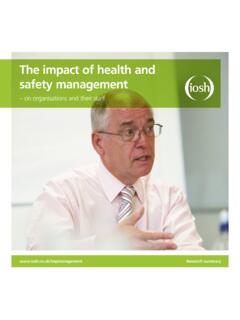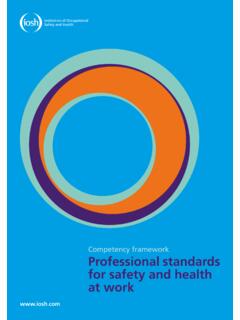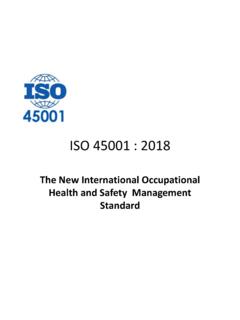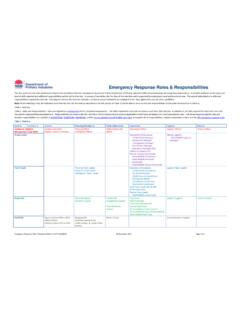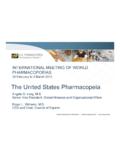Transcription of Think About Health and Safety PowerPoint Presentation
1 IOSH WebinarsDisclaimer: The information and opinions expressed in this Presentation are those of the author/presenter and not necessarily those of the Institution of Occupational Safety and Health (IOSH).Process Safety AwarenessBeginner's Guide to Process SafetyIOSH Hazardous Industries and Offshore Groups Joint PresentationBy ShaileshPurohitWhat do you Think led to this incident?Now Watch this video: Filling blind-This is an incident video of a manual operation for a typical Oil storage and Distribution facility using non-automated equipment and manual level Checks-What are your thoughts?-What if the level gauges did not read correct?(Courtesy: Chemical Safety Board, USA)4 Filling Blind Animation: Courtesy: Chemical Safety Board USObjectives of the PSM Awareness (Process Safety Management) Training) Define process Safety Explain the difference between Occupational Safety and Process Safety Describe the Ten Pillars of Compliance elements of process Safety as applicable to Oil Storage & Transfer operations Outline consequences of Process Safety failures Highlight the key part played by human factors (people) in achieving high Process Safety standards6 HSE Response to the Buncefield DisasterCourtesy: ITN NewsWhat is Process Safety ?
2 Process Safety generally refers to the prevention of unintentional releases of chemicals, energy, or other potentially dangerous materials during the course of chemical processes that can have a serious effect on the plant and environment. Process Safety involves, for example, the prevention of leaks, spills, equipment malfunction, over-pressures, over-temperatures, corrosion, metal fatigue and other similar conditions. Process Safety programmes focus on design and engineering of facilities, maintenance of equipment, effective alarms, effective control points, procedures and training. It is sometimes useful to consider Process Safety as the outcomeor resultof a wide range of technical, management and operational disciplines coming together in an organised way. 8 Occupational Safety relates to personal Safety of the employees/ contractors/ visitors however, process Safety refers to the actual operational Safety and prevention of long term harm to from ENFORM: The Safety Association for Canada s Upstream Oil & Gas IndustryInjuries from poor manual handling or exposure of an employee to toxic vapours would be considered under occupational Safety Safety management would refer to fire/ explosion/ toxic vapour releases that affect surrounding from ENFORM: The Safety Association for Canada s Upstream Oil & Gas IndustryProcess Safety incident results in a catastrophic event including long term pollution.
3 Occupational Safety incident would affect personal Safety of an employee or a few of the is no dividing line between the two types of Safety and a consequence could be attributed to both from ENFORM: The Safety Association for Canada s Upstream Oil & Gas IndustryTen Pillars of Compliance Approach to Process Safety -What are the Ten Pillars of Compliance and how do they relate to Process Safety ? List of Ten Pillars of Compliance as followed by Competent Authority (HSE + EA) 1 - Safety Management 2 -Ageing 3 4 - Safety Instrumented 5 6 -Secondary and Tertiary 7 -Internal Emergency 8 External Emergency 9 -Process Safety Performance 10 - Safety Leadership12 This Happened In UKClips taken from An Engineer s View of Human Error-I ChemE -Adventures of Joe Soap Ten Pillars of Compliance Rating as per Competent Authority13 Situation UnacceptableRed StopDangerous &/or illegal SituationVery Poor PerformancePoor StandardBroadly CompliantGood Standard / PerformanceExcellent level of Compliance, Standard & PerformanceExemplaryBest PracticeAction RequiredCease activity and rectify before Plan for improvement required within 3 days, signed-off by CE and relevant Line needed within a very short timescale Action plan within 1 week.
4 Signed-off by relevant Senior Manager and Line Plan required to be in place and being worked on prior to next inspection, signed-off by the relevant Line to detail with site lead how best to improve the issues and drive forward CIP has adopted many areas of best positive has adopted best practices in all areas with total adherence to the providing positive feedback issued to all site employees signed by the Description 10 Strategic PillarsNone of success criteria of success criteria not met or not fully success criteria not met or not fully success criteria not fully met. May not preclude close out depending on scope of improvements required and operator practice in most respects. Most success criteria practice or above in all respects. All success criteria fully Description H&S TermsVery high risk of serious injury or or imminent risk of MATTEC lear breach of legal requirements / no evidence of systems or management controls of any and / or management controls not being utilised or adhered risk of fatality or serious risk of of legal requirements / no evidence of systems being used in of serious environmental LoCSome breach of legal requirements systems not being used on this / systems need further improvement to ensure effective management controls in place and being adhered to.
5 Elements of the SMS are not being adhered to but the site, or elements of the works, which is being scored are legally performance noted on the site is well beyond system compliance but it not deemed innovation Standard industry best being adopted across the businessIndustry best practice in 1 - Safety Management System Evidence of PTW (permit to work) , Operation & Maintenance Procedures, Management of Change, Hazard Recognition & Reduction, Safety Reports, Bow Tie Reports, HAZOPs, etc. Which of the following disasters were a result of poor or total lack of management of change? Flixborough 1974 28 dead Piper Alpha 1988 167 dead Bhopal Toxic Gas Tragedy 1984 Estimated 8000 immediately and up to 20,000 later on and still affecting new-born Do you Think your Organisation is good at managing change?
6 Why?14 PILLAR 2 -Ageing Plant Ageing is not About how old your equipment is; it s About what you know About its condition, and how that s changing over time . There are well known corrosion mechanisms that Engineering Departments deal with daily and take actions to prevent/ minimise these so as to prevent loss of containment. In case you are wondering what causes plant to age, the following are all reasons: Corrosion, stress, erosion, fatigue, embrittlement, physical damage, spalling (degraded concrete), subsidence, weathering, expansion/contraction due to thermal changes, instrument drift, dry joints and detector poisoning. These ageing mechanisms can affect primary containment such as tanks and pipelines as well as supporting structures such as pipe bridges and supports, electrical, control and instrumentation systems and safeguard systems.
7 15 Tank has been decommissionedPILLAR 3 Competence What is your understanding of Competence Is it training and experience ability to do a task according to standard procedures? Would you call ability to respond under pressure competence? Competency aspect of operating a COMAH Site includes many other aspects such as Recruitment, Performance Management. All these and much more. The ability to carry out Safety critical tasks correctly every time is a key process Safety requirement. So, which of the following do you Think is a Safety critical task Option 1: Safety induction of visitorsOption 2: Line breaking for maintenanceOption 3: Wearing correct personal protective equipment16 Clips taken from An Engineer s View of Human Error-I ChemE -Adventures of Joe Soap PILLAR 4 - Safety Instrumented Systems Prevention of loss of containment and fire/ explosion is based on reliability of Safety Instrumented Systems (SIS) An example of such equipment is shown here.
8 This is a level gauge which alarms when pre-set levels are reached and also may take executive action by closing inlet valves to prevent overfilling. Another example is Interceptor Pollution Probe which alarms upon detecting oil and in some cases-also shuts the final valve leading to public water 5: Overfill18 Overfill of the tanks is one of the most common process Safety events that may lead to fire/ explosion or severe environmental contamination. Factors that we must get right are: People competent and following route cards every single time Use of Maintenance Systems to inspect/ proof test all Safety critical plant and equipment Use of Containment Policy Score Cards to identify improvement areas & Site Improvement PlansReproduced from CSB Incident Report on COPECOPILLAR 6: Secondary & Tertiary Containment Secondary Containment refers to Bunds that would catch any loss of containment from primary containment such as steel tanks.
9 Concrete Jackets surrounding the tanks do not meet the criteria for secondary containment. Tertiary Containment refers to containment of product that has overtopped secondary containment and usually could be shown as dams/ pools/ lagoons on site19 Courtesy: CIRIA 764 Guidance PILLAR 7 -Internal Emergency Plans MAPP: This is Major Accident Prevention Policy and sets out the framework and commitment of the Company to prevent Major Accidents. PIZ: Pubic Information Zones are established by the Competent Authority based on Safety Report reviews to provide area surrounding sites where the public must be provided key emergency information About our site and what to do in case of a COMAH alarm sounding Exercises: Invite local fire authorities to the site regularly to conduct annual on-site table top or physical exercises to keep them updated and also comply with the Regulatory Expectations Emergency Procedures are continuously reviewed and updated as new changes to the site are 8 External Emergency Plans.
10 The External Emergency plans are prepared by the Local Authority and has input from all emergency responders such as the Fire Brigade, Police, Ambulance, public Health England, HSE, Environment Agency, Highways Authority, Water Authority and so on liaison Meetings are held regularly with the Local Council to plan for and execute External Emergency exercises. These exercises are a legal requirement and must be done every 3 years. At a recent External Emergency Plan exercise, over 110 participants in various roles such as players, observers and umpires at strategic and operational levels were present. There was a hot and cold debrief after the conclusion of the successful exercise. The aim of these exercises is to validate the External Emergency Plan and continuously improve observed 9 -Process Safety Performance Indicators Process Safety Performance Indicators (PSPI) provide assurance to the stakeholders that process Safety issues are being managed to prevent catastrophic , these are risk control barriers such as Operator Competence, Operational Procedures, Management of Change and Permit to Work and so on.

